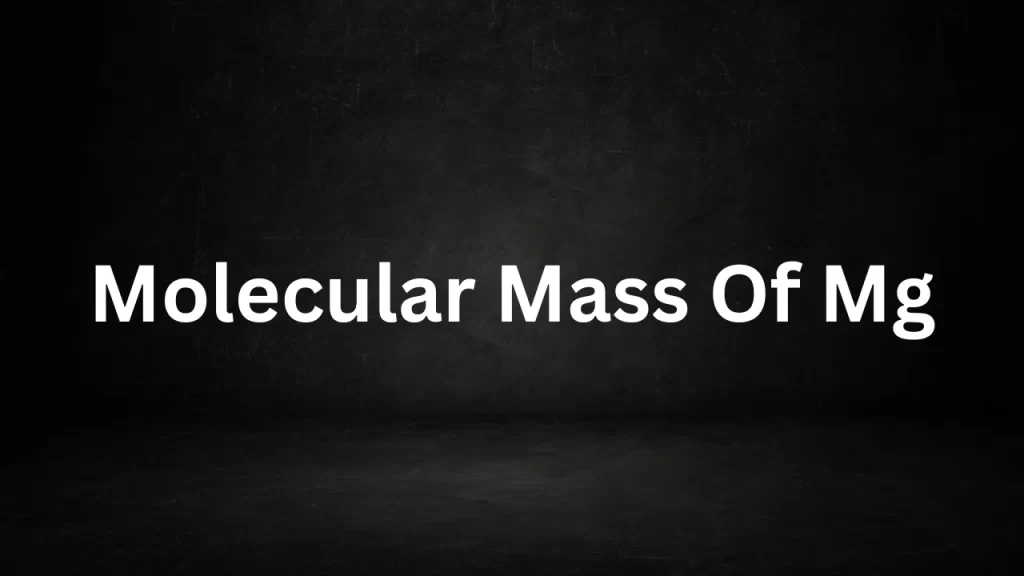Tag: mg no3 2 6h2o molecular weight
Molecular Mass Of Mg
Molecular Mass Of Mg: Molecular mass, often referred to as molecular weight, is a fundamental concept in chemistry that plays a crucial role in various scientific applications.
In this article, we will delve into the world of mole mass, with a specific focus on the mole mass of magnesium (Mg). Magnesium is a versatile and essential element with numerous applications in both nature and industry, making an understanding of its mole mass of significant importance.

Molecular Mass Of Mg
The Chemical Symbol for Magnesium
Before discussing its mole mass, it’s crucial to identify magnesium by its chemical symbol ‘Mg’ and its place on the periodic table. Magnesium is located in Group 2, Period 3, and is classified as an alkaline earth metal on the periodic table. It is the eighth most abundant element in the Earth’s crust and is vital for various biological and chemical processes.
Atomic Structure of Magnesium
To comprehend the mole mass of magnesium, it’s essential to first look at its atomic structure. Magnesium has an atomic number of 12, indicating it has 12 protons in its nucleus. The most common isotope of magnesium is Mg-24, which means it has 12 neutrons in its nucleus. The atomic mass of magnesium is approximately 24.305 atomic mass units (amu). This is the average mass of all naturally occurring isotopes of magnesium, taking into account their relative abundances.
Molecular Mass of Magnesium
The mole mass of an element is calculated by adding up the atomic masses of its constituent atoms. However, magnesium is rarely encountered in its molecular state in nature due to its metallic properties. Metals tend to form crystalline structures with closely packed atoms, not discrete molecules. In its natural state, magnesium exists as the diatomic molecule Mg2.
To calculate the mole mass of magnesium, we add the atomic masses of two magnesium atoms:
Molecular Mass of Mg2 = (Atomic Mass of Mg) x 2 Mole Mass of Mg2 = (24.305 amu) x 2 Molecular Mass of Mg2 = 48.61 amu
So, the mole mass of magnesium (Mg2) is approximately 48.61 atomic mass units (amu).
Significance of Molecular Mass
The mole mass of magnesium is important in various applications, including chemistry, physics, and biology. Here are some areas where understanding the mole mass of magnesium is crucial:
- Chemical Reactions: In chemical reactions involving magnesium or its compounds, the mole mass is utilized to ascertain the amounts of reactants and products. This data is essential for stoichiometry, a fundamental concept in chemistry that aids chemists in precisely establishing the quantities of substances required and generated during a reaction.
- Analytical Chemistry: Mole mass plays a crucial role in analytical techniques such as mass spectrometry, which helps identify and quantify compounds in a sample.
- Biological Processes: Magnesium is an essential element for living organisms, and its mole mass is significant in biological research and pharmaceuticals.
- Material Science: In the development of magnesium alloys for various applications, understanding the mole mass of magnesium aids in designing and engineering materials with specific properties.
Conclusion
The mole mass of magnesium, approximately 48.61 amu for the diatomic molecule Mg2, is a fundamental concept in chemistry and various scientific fields. It allows scientists and researchers to make precise calculations in chemical reactions, analytical chemistry, biology, and material science. Understanding the mole mass of magnesium is essential for harnessing its versatile properties and applications in the modern world.
Read More
- Molecular Mass Of Iodine
- Molecular Mass Of Sugar
- Molecular Mass Of Copper
- Molecular Mass Of Cl2
- Molecular Weight Of K
Frequently Asked Questions (FAQs) On Molecular Mass Of Mg
1. What is the molecular mass of magnesium?
The mole mass of magnesium is approximately 48.61 atomic mass units (amu) when considering its natural diatomic form, Mg2.
2. Why is the molecular mass of magnesium important?
The mole mass is important in chemistry and various scientific disciplines as it helps in stoichiometric calculations, analytical chemistry, and understanding the properties and behavior of magnesium in chemical reactions.
3. Can you provide an example of how the molecular mass of magnesium is used in chemistry?
Certainly! In a chemical reaction where magnesium (Mg) reacts with oxygen (O2) to form magnesium oxide (MgO), the mole mass of magnesium helps determine the amount of magnesium needed and the amount of magnesium oxide produced based on the stoichiometry of the reaction.
4. Are there any health-related implications of magnesium’s molecular mass?
Magnesium is an essential mineral for the human body, and its mole mass is significant in dietary and pharmaceutical contexts, as it affects the dosage and bioavailability of magnesium supplements and medications.
5. What are the practical applications of understanding the molecular mass of magnesium?
Understanding magnesium’s mole mass is vital in chemistry, analytical techniques (e.g., mass spectrometry), biology, and alloy development in materials science.